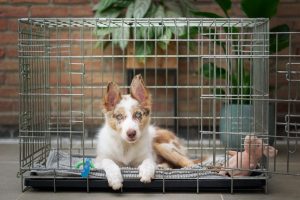
Training your dogs is part of their growing process, one of the things you need to train them on is remaining in their cage or crate.
Many people are concerned about crate training their dogs, as they are unsure of how to get the dog to settle down in the crate. However, a dog crate is simply like a den for the dog, and with a little time and patience, your dog will learn to love its crate. Mother dogs and their pups typically live in dens in the wild. Dens are quiet, snug areas where the dog can rest and feel safe and warm. You are simply returning your dog to its natural state. To make your dog feel more comfortable, provide a soft bed and cover the top part of the cage with a towel. This will create a sense of security for your dog.
Your crate needs to be large enough for your dog to stand and turn around in. Any smaller and it will be uncomfortable and any bigger and the dog won’t feel like it’s in a den, since primarily dogs like to feel safe and secure.
Dogs are typically pack animals who enjoy being in close proximity to their family members, as they are able to see and hear them. This way, they know that their pack, or you and your family are nearby. A good place for your crate is somewhere your dog can see you, but not near a radiator or draught. Some people like to have two, one in the main living area and another in their bedroom. The placement is all up to you, but remember it is supposed to be somewhere they feel warm and safe.
Training dogs to use a crate is easier if you start when they are young. With a little time and patience, you can train an older dog just as successfully as a younger one. In fact, older dogs can be trained quite effectively.
Let your dog get accustomed to the presence of the crate by placing a familiar object like a towel or bed inside. Don’t try and force the dog into the crate, let them realize it won’t hurt them. As your dog becomes more comfortable with the crate, begin to place toys or treats inside and let them go in to get them. This will help your dog associate the crate with positive things and they will eventually be content to stay inside and either eat the treat, play with their toy, or just sleep.
As your dog becomes accustomed to the crate and being inside, start closing the door for short periods of time. Remain close by so your canine doesn’t get concerned. Just gradually increase this time and then start leaving for short periods, allowing the dog to become accustomed to being in the crate. You can gradually increase the amount of time you are away from your dog so that they are aware that you will always come back and feel secure.
Do not leave your dog unattended for long periods of time and be sure to take them on walks and play with them when you are present.
House Training or Potty Training
Dogs have an instinctual desire to keep their sleeping area clean and dry. This is something they are born with and is not something that can be taught. Puppies are shown by their mothers how to keep their sleeping area clean. When house training a puppy, they will try to keep their crate clean since they were taught how to do so by their mother. However, puppies cannot hold themselves for long, so make sure to let them out every hour.
As dogs age, they can better control their bladder and bowels, but still need to go outside frequently. If you take your dog on regular walks and allow them time to relieve themselves, they will quickly learn to be house-trained.
Separation Anxiety
Some dogs experience anxiety when their owners leave them alone. This can manifest in different ways, such as howling or chewing. The crate will help the dog feel warm and safe, while also preventing anxiety if the dog is used to it from training.
When your dog is comfortable with their crate and sees it as a safe place, they will act like it is their den. This will help them stay calm and chew less. As long as they are in the crate, you can be certain that they will not be able to chew or damage any part of your house, giving you a sense of relief. Leaving a garment such as a jacket or towel which has your scent on it in the crate will also help to calm and reassure the dog.
Chewing or teething
Some dogs have a tendency to chew, especially when they are younger. They do this for a variety of reasons, such as anxiety or boredom. Coming home to a house that has been destroyed by your dog is not a good way to maintain a good relationship between you and your dog.
A crate will help to keep your dog safe and reduce the risk of it getting hurt or bored. Chew toys left in the crate will occupy the dog and prevent it from becoming bored. For younger dogs, a Kong filled with frozen gravy or biscuits will help to relieve boredom. The dog crate is not a place to leave your dog for extended periods of time. It is meant as a way to keep your dog safe and contained when you are not able to watch them.
Crate training can be beneficial, but you have to be careful and follow some simple rules to ensure your dog sees it as a safe place and not somewhere they feel they are being imprisoned.
Do not try to make your dog go into the crate by force – let the dog gradually get used to it being in there, and then start to leave them in there for increasing amounts of time, until they feel relaxed and comfortable. Do not leave your dog alone for long periods without taking them for a walk. Clear the crate of any chains or tags that could get caught on something. Make it as comfortable as possible with toys and treats, and leave it be.
Make sure the crate you choose for your dog is large enough as dog crates come in all sorts of shapes and sizes. There are plenty of dog crates available for both small and large dogs, so you should be able to find one that suits your needs.
Pet crates can be extremely helpful for dogs in training. They provide a space for the dog to be away from distractions and work on their behavior with their owner’s help. Crates are not meant to be a way to simply fix behavioral issues, but rather help owners identify and work on them with their dog.
These crates are also helpful for transporting your pets or just for them to relax in whenever you aren’t around or too busy, make sure that their crate is a safe space for them to remain in.
 wagwagtail "only love can make your dog wag her tail"
wagwagtail "only love can make your dog wag her tail"
